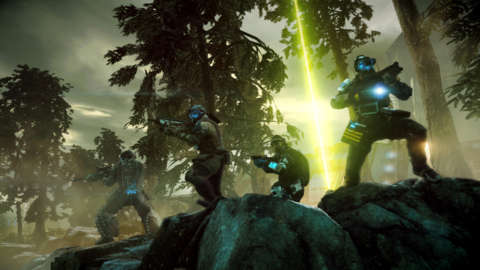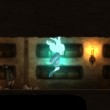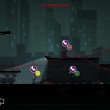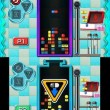Killzone: Shadow Fall Intercept Review
What's your favorite kind of co-op shooter? The ultra-competitive, team-based thrills of a Battlefield Domination match? The wave-based panic of Gears of War's Horde mode? Or maybe you're partial to the strategic gore-fest that is a game of Left 4 Dead? Judging by the four-player co-op on offer in Killzone: Shadow Fall Intercept, developer Guerrilla is very much a fan of all three. But while those games carefully home in on a single mechanic, much to their benefit, Intercept is a rather heterogeneous creation by comparison.
Don't get me wrong: Intercept's class-based, four-player co-op is by no means an awful thing. But after a day of showing hundreds of Helghast the business end of a shotgun, I can't shake the feeling that it tries to do far too much for its own good. Fun was had, but not the sort of rollicking good time that made me want to shout about it afterward. Take the four classes on offer, for example: the assault class is armed to the teeth, the tactician lays turrets, the medic heals and revives fallen allies, and the marksman brings up the rear with a sniper rifle.
These are the archetypal class roles for a shooter, which would be fine, except that there's nothing about any of these classes that stands out from the regular Shadow Fall fare. Sure, there's the class-wide ability to wield a drone for protection, the odd speed boost, and the ability to lay shields or ammo packs. But all the classes handle the same, so the heavy isn't any slower than the medic, for example. Even their weapon selection becomes a moot point once you've unlocked some new ones (there are 20 in total to choose from, including those from the Insurgent downloadable content pack), giving you things like a shotgun-wielding medic that's pretty good in a firefight.
Customization is nice to have, but limitations are often there in co-op for a reason, and in the case of Intercept, it would have made each character feel that little bit more special. That mundane feeling extends out onto the battlefield, where you must defend three control points from waves of AI Helghast, while also racking up a certain number of points for your team to win the match. Each map consists of a home base, where a spot called a bank lies. Therein lies Intercept's core risk/reward mechanic. You earn points by killing Helghast and healing teammates and the like, which increases your score multiplier. However, if you get killed, all those points and your score multiplier disappear.
I can't shake the feeling that it tries to do far too much for its own good.
To win the match, it's your team's score, not yours, that counts. That means periodically running back to base to deposit your points while weighing whether to hang onto them for a higher score or risk losing them all. You can kill hundreds of Helghast, but if you keep getting killed and fail to deposit points, the match will go on indefinitely, or at least until you hit zero points. Respawning without a medic costs 50 points, so going without a healer is an entirely possible scenario if everyone's a bit gung ho with deposits.
On paper, that sounds like an interesting, even potentially entertaining, mechanic. But while it has its moments, there's just not enough depth for it to hold your attention for long. Matches quickly become a repetitive slog of smashing out a few kills and running back to base to cash them in. There's little incentive to build up those big score multipliers, because more often than not, a slow and steady buildup of points easily wins the match.
Unfortunately, there's little else in Intercept to liven the action. Carrying capacitors back to purchase temporary power-ups like miniguns, damage boosts, and bunny-hopping jetpacks is fine, but the capacitors themselves often spawn in exactly the same place, while the power-ups lack the visual pizzazz to make them interesting. I want to know when I'm doing double damage, or am suddenly armed with a jetpack and machine gun. I want the game to shout it out at me, flash some killer graphics on the screen, and make me feel like I've really achieved something, rather than just timidly changing a tiny icon at the bottom of the screen.
Then there are the Helghast themselves, who we're told are powered by an AI commander that picks the best strategy based on your progress. (Sound familiar?) Certainly, there were some particularly hairy moments where the AI had my team surrounded and vastly overpowered. Only by working together as a team, carefully placing turrets around capture points, healing where necessary, and sniping from afar, were we able to overcome them. But these moments were the exception rather than the rule, and even then, it seemed the AI was merely throwing more soldiers at the problem rather than coming up with some kind of intelligent strategy.
Interspersed between the regular enemies and the losing and capturing of control points are the boss battles, which are extremely disappointing. Much like how Gears would send out a grinder, or L4D would send out a tank to spice things up, Intercept wheels out bosses based on characters from the single-player campaign. However, these bosses are a feeble imitation. The most I ever saw one do was teleport to another area of the map, or cloak, but otherwise, there was little to tell them apart from a standard enemy other than a higher health bar and some cheesy voice-over.
All the elements are there for a good time in Intercept, but none shine enough on their own to be melded together into a cohesive whole. The four maps Intercept is currently set in--Market, Highway, DMZ, and Outpost, with six more on the way for free--are at least well designed, even if the mysterious blue shield walls around their rims sometimes prevent you from making the flanking moves you so desire. The usual array of leaderboards, challenges, and trophies make up the metagame, while three different game lengths (based on the total number of points needed to win) mean you can play small, 15-minute skirmishes, all the way through to epic hour-long battles.
Whether Intercept can keep you entertained for such lengths of time, I'm not so sure. It takes just a few matches to realize that the magical multiplayer spark, that itch that must be scratched by just one more match, is sorely lacking. This is a technically competent add-on that feels like it was designed to latch onto a growing co-op trend and to plug a gap in the game's multiplayer repertoire because the market research said to, rather than something designed with some real heart and soul behind it.









